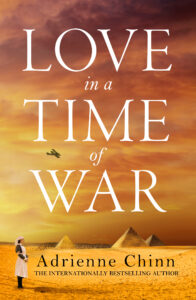In 1914 the youngest Fry sister, Etta, is thrust into the bohemian world of the Bloomsbury Group through her lover, the Italian artist Carlo Marinetti. They attend a weekend at the Sussex home of Virginia Woolf, and the conversation turns to the war.
 Etta sits in a canvas lawn chair on the stone patio behind the house, where the group has clustered on lawn chairs amongst the roses and honeysuckle trailing over trellises … She looks over at Virginia’s husband, Leonard, and watches him make notations in a black-covered notebook in his lap.
Etta sits in a canvas lawn chair on the stone patio behind the house, where the group has clustered on lawn chairs amongst the roses and honeysuckle trailing over trellises … She looks over at Virginia’s husband, Leonard, and watches him make notations in a black-covered notebook in his lap.
‘Mongoose, whatever are you listing now?’ Virginia says to her husband. ‘The spoonfuls of sugar we’ve consumed in our tea?’
‘If you must know, my dear mandrill, the cost of John Teasel’s cream has gone up by three pence. I must keep abreast of these things or we shall be living in penury before you know it.’
‘We already live in penury, Mongoose.’
Virginia’s sister, Vanessa, sets down the canvas she is embroidering with roses and playing cards. ‘Why on earth are we talking about the cost of cream? War has just broken out. Why is no one talking about that?’
Roger Fry spoons a dollop of strawberry jam onto a scone. ‘What is there to say, Vanessa? There will be a few skirmishes over on the Continent, exactly like what happened in the Franco–Prussian War, and everyone will be home for Christmas, which is fortunate as we shall have a fully stocked shop for the holidays.’
Etta sets her teacup down in the saucer in her lap. ‘The train station in Brighton was heaving with soldiers leaving on trains for London. I almost missed the train to Glynde because of them. They were all very jolly, like they were going off to a party, singing songs and everything.’
Virginia’s long, serious face brightens. ‘Really? What were they singing?’
‘It was all about Tipperary. Quite a jolly song.’
Leonard slams shut the notebook. ‘It’s all senseless and useless. It’s absolutely ridiculous to solve political disagreements by violent force. Italy has the right idea. Staying neutral.’
 Roger brushes a crumb from his lip. ‘Hold on. Wasn’t Italy signed up with the Austrians and the Germans in the Triple Alliance before the war broke out? Shouldn’t you be on the other side, Carlo?’ He taps his lips. ‘Maybe we ought to watch what we say around you.’
Roger brushes a crumb from his lip. ‘Hold on. Wasn’t Italy signed up with the Austrians and the Germans in the Triple Alliance before the war broke out? Shouldn’t you be on the other side, Carlo?’ He taps his lips. ‘Maybe we ought to watch what we say around you.’
Carlo leans back in the lawn chair. ‘The war in Europe is none of Italy’s, or my, affair. If anyone steps onto Italian soil, this, of course, will be another matter.’
Virginia sets down her teacup with a rattle. ‘War is just a preposterous masculine fiction. The chief occupations of men are the shedding of blood, the making of money, the giving of orders, and the wearing of uniforms. I have had quite enough of it already.’ She turns to Duncan, who is scribbling doodles in a scrapbook. ‘Duncan, tell me, who are you sleeping with this month? Anyone here?’
Visit the Sussex home of Virginia Woolf’s sister, artist Vanessa Bell: https://www.charleston.org.uk/
Caption for photo: L to R: Lady Ottoline Morrell, Maria Nys, Lytton Strachey, Duncan Grant and Vanessa Bell at Charleston House, West Sussex. Photographer unknown.















